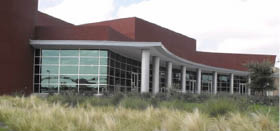
PAC's Performing Arts Center provides music, dance and theatre venues for the South Side of San Antonio.
Photo by Adelina O. Valdez
The Capital Improvement Project, which has provided new classrooms and state-of-the-art resources to Palo Alto students, is beginning to show signs of completion.
The bond that funded the project was passed in 2005. Voters approved $450 million for the five Alamo Colleges, and Palo Alto's share was $55 million.
A public celebration on Nov. 6, 2009, from 3:45 p.m. to 7 p.m. at Pearl Stables Brewery will recognize the work that was put into updating and expanding the five Alamo Colleges.
The CIP has been a long and, at times, grueling process. After about four years of planning, construction, and shuffling students from old buildings to portables to new buildings, we are finally getting closer to a finished campus.
Widespread construction, blocked-off parking spaces and more students on campus have contributed to an aggravating parking problem in key areas. Plans to add more parking spaces are not on the agenda.
Dean of Student Services Robert Garza, former CIP liaison, said, "It's a double-edged sword… I am so happy that we have a parking problem."
Sabrina Carey, assistant to the president, and Chris Delgado, coordinator of College Technology, are now acting as the liaisons for the Capital Improvement Project since Garza became a dean.
While the parking issue is a pain, it also documents the increase in those attending Palo Alto. Enrollment shot up by six percent this fall compared to last fall, with 500 more students now on campus.
One of the biggest and perhaps most noticeable results of the bond funding is the college's new Performing Arts Center, located just off 41.
Now dance, theatre and music students are able to perform on a variety of stages as opposed to the college's previous Performing Arts Building, now renamed the Fine Arts Building, which only had one major performance space.
Not only is the new red building beautiful and well designed, it houses resources that have never existed for Palo Alto students, such as a recording studio, a piano lab, a large professional dance studio and a 400-seat theatre.
According to Bailey Lathem, chairperson of the Fine and Performing Arts Department/Speech Communication, the new center provides room and a proper setting for new classes.
The most important thing about the new space, Lathem said, is that it is the only one of its kind on the South Side of San Antonio. This is important because the Performing Arts Center will not only benefit Palo Alto students, but it will also benefit the surrounding community since it may be booked by the public for events and performances.
"The new Performing Arts Center is great. Everything looks so high tech," said Palo Alto Sophomore Krystle Riojas, an Art major.
Freshman Criminal Justice Major Nicolette Muniz said, "I think it's super nice…my major isn't in performing arts, but I think it plays an important role. It's open, and it's vibrant."
Renovations have also been made to existing buildings, such as the Ozuna Learning Resource Center, Fine Arts Building (formerly called Performing Arts), Gallery and Sculpture, (formerly called Fine Arts), Executive Offices (formerly called Administration) and the Student Center.
Renovation is still underway on some parts of campus, like the Palomino Center and the Social Sciences, Business, Math & Science and Applied Sciences Buildings. The CIP has also added the Veterinary Technology Complex and the Science and Workforce Building, which will have its grand opening on Nov. 13, 2009, at 10 a.m.
Although the portable buildings had their place in the CIP, the seemingly permanent structures will be removed once construction is finished./p>
More changes will come for Palo Alto in the future. Garza said that eventually they hope to place parking on the campus' perimeter with all buildings centralized. This design will help alleviate some of the parking issues and make it safer for students to walk from class to class without having to cross traffic.